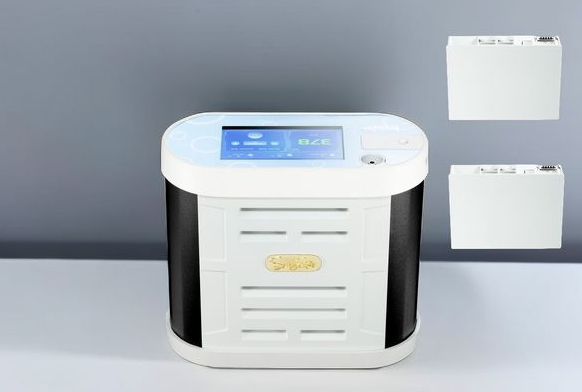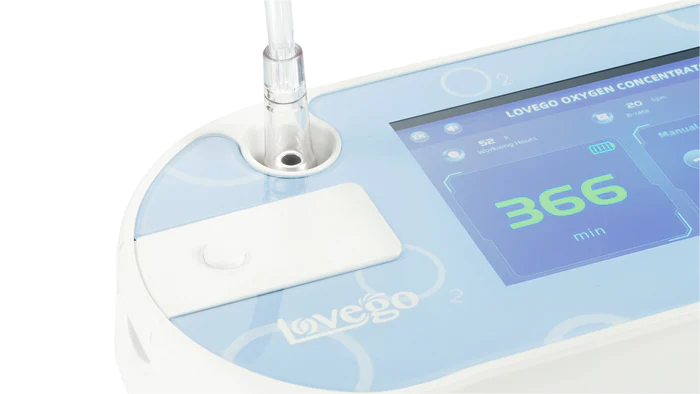Traveling with a portable oxygen concentrator offers freedom and flexibility for oxygen therapy users. However, road trips require some additional planning and preparation to ensure smooth, trouble-free journeys. This article provides useful tips for car travel with a portable oxygen concentrator.
1. Check Power Options
Fully charging the portable oxygen concentrator prior to the car trip is a critical first step, as most portable models only run on battery for limited hours. To calculate the expected duration, factor in the total drive time plus potential traffic delays, rest stops, and any other contingencies. An hour-by-hour timeline helps assess total power needs. For longer trips beyond 4-5 hours, consider also packing an extra rechargeable lithium battery, which can double the available run time. Alternatively, bring an adapter to plug the device into the car's DC outlet for uninterrupted operation while driving.

2. Secure the Device Properly
Protecting portable oxygen equipment from vibration or impacts requires properly securing units while driving. Ideal positioning is on the floor behind the front seats, as this area limits risks of device sliding or collisions during braking, acceleration, or evasive maneuvers. Looping rugged straps through the handle slots and anchoring tightly onto seat tracks prevents side-to-side motion. Alternatively, high-density foam braces shaped to fit the unit snugly also minimize jostling that could disconnect internal tubing links or electronics. Check fittings every 2-3 hours enroute to ensure connectors remain fully plugged in.
3. Bring a Backup Oxygen Supply
While meticulous power planning optimizes output reliability, having backup oxygen as a safety buffer allows peace of mind when navigating the uncertainties of travel on the open road. A compact "D" cylinder with an integrated regulator selected for dose-specific flow control provides easily portable and rapidly deployable supplemental capacity as needed. This could make the difference in successfully bridging gaps posed by an accidental power drain, prolonged wait in traffic congestion, or any other threats to the continuity of optimal therapy. With training, most users can comfortably switch over in minutes.
4. Protect Tubing from Dislodging
Preventing dislodged nasal cannulas or tubing disconnects requires attention to positioning, movement dynamics, and catching risks while riding in vehicles. Allow slack tubing length, enabling at least 18-24 inches of lateral head rotation or flexion without pulling. Locate the oxygen concentrator higher than the user if possible so the tubing hangs freely without stretching. Protect exits with a soft shoulder strap wrapped in felt - when moving in/out, thread tubing through this gently curved guide instead of dangling loose. Periodically check the pathway to ensure kinks don't obstruct free flow.
5. Conserve Battery Life
Driving for prolonged periods inevitably requires utilizing the car's electrical system to charge phones or power laptops and tablets for navigation, entertainment, or work needs. However, being mindful of charging cycles can significantly optimize usable oxygen concentrator runtime. Check devices before departing and postpone non-essential charging. For gadgets needing mid-trip boosts, wait until the car is moving to tap into alternator power rather than battery reserves alone. Time charges during shorter stops since most portable oxygen batteries drain faster when stationary. Switch at outlets whenever possible. Little adjustments cumulatively prevent premature depletion.
6. Maintain Proper Airflow
While driving, slightly opening side windows facilitates airflow circulation within vehicle interiors. Stagnant cabins allow exhaled oxygen to be consumed faster in tightly enclosed spaces. Dedicated ventilation fan settings on the dashboard also help maximize air exchange. Optimizing movement mitigates local depletion effects that could hasten the onset of oxygen desaturation symptoms. Enroute users should observe for any increased fatigue, irritability, or mental fogginess that could signal suboptimal circulation. Pulse oximetry spot checks further confirm the ongoing efficacy of delivered flow rates.

7. Carry Respiratory Medications
Having emergency respiratory medications readily accessible provides security for lung disease patients making road trip excursions across varying environments. Bronchodilators act fast to relieve acute onset wheezing or asthmatic attacks triggered by weather shifts or exposure to seasonal allergens or airborne irritants. Carrying an extra few days' backup supply of maintenance oral or inhaled steroids also helps manage any sudden worsening of underlying inflammatory conditions. Even users who are normally stable day-to-day should pack rescue treatments when venturing away from their local area due to uncertainties of travel.
8. Check Oxygen Settings
Before embarking, reconfirm portable concentrator settings align with your doctor's latest prescribed flow rate recommendations for day-to-day needs, plus any advised dosing adjustments to accommodate extra physical, mental, or environmental stressors uniquely associated with extended time sitting in transit. Compare current vehicle trip plans against previous mobility outings to help gauge anticipated challenges and exertion levels based on personal experience. Remember to periodically reassess flow rate adequacy via oximetry feedback to ensure optimal therapeutic oxygenation as journey circumstances and demands change.
9. Consider Pressure Changes
When driving through high-altitude mountain areas, understanding the impacts of pressure fluctuations can help inform appropriate portable oxygen setting adjustments. Ascending in elevation typically decreases barometric pressure by 3-4% per 1000 feet gained, which proportionally lowers delivered oxygen molecules per volume flow. Descending has the opposite bolstering effect. Vehicle cabins insulate occupants from feeling these ambient air density shifts, but flow rate tweaks counterbalance changing concentrations to maintain optimal saturation. Check settings against elevation tables for your device. Also, monitor breathing comfort and oximetry readings when significantly gaining or losing altitude and tweak the dial accordingly within the doctor's guidance.
10. Prepare Navigation Plans
Meticulously mapping out the intended route and stopping details before embarking makes driving less stressful while optimizing oxygen management on the go. Pinpoint total mileage as well as terrain elevation changes to estimate battery runtime needs and recharge timings. Plot locations of gas stations, restaurants, and rest stops offer access to electrical outlets that enable periodically replenishing portable unit batteries when stationary. Building even an extra 30 minutes of recharge margin into the timeline provides a flexibility buffer without the anxiety of an unexpected drainage mid-transit. Anticipate and mitigate hazards through deliberate power planning.
11. Minimize Carry-on Accessories
When transferring portable oxygen equipment in/out of vehicles, traveling light with just the essential accessories greatly eases mobility. Assess genuinely needed items for short trips away from the vehicle, such as glasses, medication, snacks, phone, and wallet. Keep those within a slim shoulder bag or backpack able to fit side-by-side with the concentrator case. After extended on-the-road periods, fuller accessory unpacking becomes more manageable. The priority initially is eliminating the awkward juggling between multiple cases to simply exit the car smoothly without heavy lifting strains.
12. Use Durable Travel Case
Investing in a custom-fitted, heavy-duty carrier bag designed specifically for makes/models of portable concentrators enables both protecting the delicate equipment and facilitating easier transport mobility. Quality bags feature padding, tie-downs, grab handles, and sometimes built-in retractable wheels or detachable shoulder straps. Structural rigidity prevents crushing while specialized cutouts snugly secure tubing and delicate regulators. Zipped covers guard controls, filters, and screens against dust or spills. When moving about, hand grip options enhance control on stairs while freeing up the other arm as needed for support and steadying.
13. Keep Spare Filters Handy
Carrying surplus replacement filters enables rapid in-transit swaps when concentrators display blocked flow warnings, or users sense reduced airflow volumes not remedied by output dial adjustments. Based on rated filter lifespan specifications, determine the frequency of proactive change-outs needed for your trip duration. Budget extra units padded beyond this in case bumpy roads dislodge accumulated particulates earlier than expected. Note the installation date on filters to rotate the oldest out first. Proper spares prevent disruption, uncertainty, and safety risks of oxygen deprivation far from professional help.
14. Stay Properly Hydrated
Maintaining good fluid intake counterbalances the dehydrating effects of recirculated cabin air on respiratory membranes and oxygen exchange. Prolonged exposure tends to dry out throat tissues, sometimes thickening mucus consistency. Drink small but frequent volumes of cool water. Avoid alcohol and caffeinated beverages, which have a net fluid-loss effect in the long term. Have spill-proof bottles handy to sip whenever thirsty rather than relying on scheduled stops. Keeping nasal passages moist and membranes functioning optimally enhances oxygen utilization for those already coping with underlying respiratory impairments.

15. Plan for Comfortable Clothing
Choose wardrobe options favoring loose fit and natural fibers on lengthy drives requiring supplemental oxygen equipment. Tight collars, sleeves, pants, or underlayers restrict circulation and get uncomfortably binding after sitting confined for extended periods. Breathable fabrics like cotton or linen enable better ventilation and evaporation of sweat compared to heat-trapping synthetics. Dress in adjustable layers to remove or add as ambient temperatures fluctuate when stopping/going. Most importantly, ensure clothing allows clear tubing paths without risking entanglements or unsafe disconnections.
16. Be Ready for Medical Emergencies
Hope for an uneventful journey but pragmatically prepare for dealing with an acute respiratory crisis far from home support systems. Know locations en route for emergency room access, even scoping out addresses with oxygen-equipped ambulance bays. Program your phone with ICE contacts of medical professionals familiar with your history and baseline status should first responders need expert guidance. Have a medical ID or alert bracelet clearly visible. Let traveling companions know how to assist you with oxygen equipment if breathing becomes severely labored. Stay vigilant to recognize and respond promptly to deteriorating symptoms.
17. Minimize Consumption of Lung Irritants
When road-tripping with chronic lung illness relying on consistent oxygen delivery, avoiding unnecessary airway insults improves outcomes. Skip vaping or smoking breaks entirely whilst traveling to avoid undermining fragile respiratory stamina. Request a ventilation fan on and politely ask that fellow passengers also refrain from using irritating chemicals inside the shared cabin space. If the weather allows, breathe fresher external airflow circulating through cracked windows versus stagnant, contaminated indoor air. Every little reduction of added breathing burden cumulatively assists those with impaired baseline function.
Proper planning prevents problems so you can focus on the adventure of the open road. With appropriate preparation as outlined and safety precautions in place, enjoy exhilarating independence and liberation with portable oxygen therapy on your next road journey!





Hinterlasse einen Kommentar
Diese Website ist durch hCaptcha geschützt und es gelten die allgemeinen Geschäftsbedingungen und Datenschutzbestimmungen von hCaptcha.